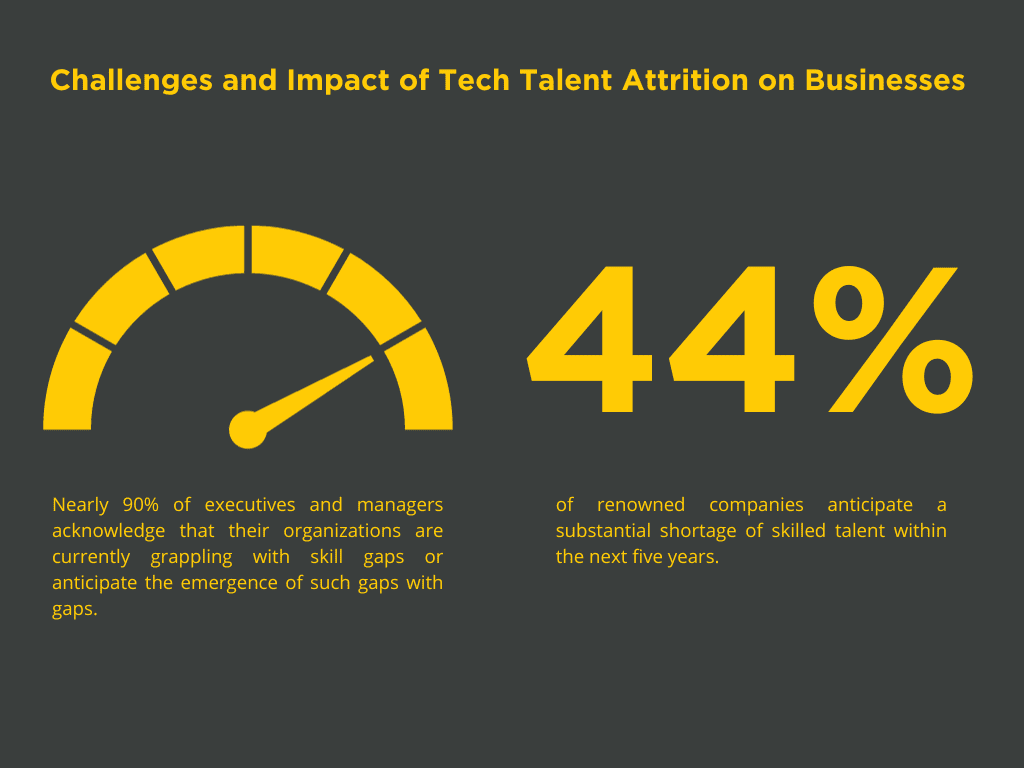Employee attrition in the tech industry is a growing concern for businesses. It not only affects financial stability but also impacts employee morale and productivity. To combat this challenge, organizations must focus on factors contributing to attrition rates, such as job satisfaction and workplace culture.
Research shows that more than 44% of renowned companies anticipate a substantial shortage of skilled talent within the decade. Nearly 90% of executives and managers acknowledge that their organizations are currently grappling with skill gaps or anticipate the emergence of such gaps.
This blog post will discuss the causes of tech talent attrition, how it affects business, and strategies to control it in your organization.
Understanding Employee Attrition
High attrition rates can destabilize businesses, impacting workforce productivity and morale. This turnover can be voluntary or involuntary, necessitating effective retention strategies. Understanding employee attrition is essential for developing these strategies and ensuring the stability of an organization. Analyzing the number of employees leaving, HR leaders can implement measures to reduce the organization’s attrition rate and mitigate the negative impact on the business. Ultimately, employee attrition has real value, and addressing it is crucial for a company’s potential return on investment.
The Rise of Employee Attrition in Tech Roles
The evolving landscape of technology has resulted in an increased number of employees departing from tech roles, impacting business operations. The digital skills gap has led to a higher average number of employees leaving their positions, influenced by rapid technological advancements. Consequently, organizations need help attracting new hires with the required skill sets, leading to high voluntary attrition rates. This, in turn, has resulted in additional work and increased labor costs for organizations, emphasizing the actual value of retaining tech talent.

The Causes of Employee Attrition and the Digital Skills Gap
Factors such as personal reasons contribute to the departure of team members, impacting the organization’s attrition rate. Opportunities for career development play a pivotal role in retaining talent, making it essential for business leaders and HR leaders to focus on skill sets and potential return employees. Additionally, the digital skills gap significantly influences attrition in tech roles, making it crucial for organizations to address the actual value of upskilling their current talent pool to combat involuntary attrition.
Factors Contributing to Tech Talent Attrition Rates
The technology industry experiences high attrition rates for various reasons that impact the departure of highly qualified individuals from their current positions. The fact that technology is developing so quickly is one crucial factor. Employees may look for new opportunities to work with cutting-edge technologies or explore different areas of their field in an industry known for ongoing innovation and change. Tech talent may seek out more dynamic and challenging surroundings due to stagnation or fear of becoming obsolete.
Workplace culture also plays a crucial role in tech talent attrition. Organizations that do not cultivate a constructive and welcoming workplace may find it difficult to hold on to their best employees. Employee unhappiness may be exacerbated by inadequate cooperation, communication, and acknowledgment of achievements. As a result, disgruntled workers may seek out other companies that place a higher priority on a positive and stimulating work environment.
Career advancement opportunities are another significant factor. Tech workers frequently have high aspirations and look for positions that allow them to advance their careers and enhance their skills. An organization must provide employees with clear pathways for professional progress or acknowledge and reward accomplishments so that their workforce can look for alternatives.
Compensation and benefits are perennial considerations. Due to the high demand for highly qualified tech workers, businesses that do not offer appealing benefits packages or competitive salaries risk losing talent to rivals who do. Retaining top talent requires understanding the market worth of tech skills and tailoring remuneration packages appropriately.
Finally, the remote work trend, accelerated by global events, has reshaped expectations around work arrangements. Companies that do not adapt to flexible work schedules or fail to provide remote work options may be disadvantaged, as many tech professionals now prioritize work-life balance and the ability to work from locations that suit their preferences.
The Role of Job Satisfaction in Attrition
Employee attrition rates are significantly influenced by job satisfaction. The experience of employees directly impacts their level of satisfaction with their jobs. Recognition of achievements and opportunities for career growth plays a crucial role in determining job satisfaction. Moreover, the workplace culture also contributes to employees’ job satisfaction. Job satisfaction directly correlates with employee retention, making it a critical factor in managing an organization’s average number of employees and controlling involuntary attrition.
The Impact of Workplace Culture on Employee Attrition
Workplace culture plays a pivotal role in directly influencing employee attrition rates. A thriving alum network can have a significant impact on the attrition of employees. The effect of company culture on employee turnover cannot be overstated, as it directly affects the retention of talent within the organization. Meaningful recognition for employees not only boosts morale but also reduces attrition rates. Company culture contributes to talent retention, showcasing its importance in mitigating the turnover of employees.
Consequences of Tech Talent Employee Attrition
The high attrition rate significantly impacts business costs, affecting workplace morale and productivity. Attrition also affects business advertisement and talent acquisition, leading to business financial implications. Implementing strategies to control and reduce employee attrition is crucial for mitigating these consequences and ensuring the actual value of the workforce is maximized.
Financial Impact of a High Attrition Rate
The high attrition rate in organizations results in hidden costs that impact businesses financially. It requires significant time and effort to address the financial implications of attrition. A high turnover rate leads to additional work to fill vacant positions, posing challenges in retaining top talent. The associated costs of attrition directly impact business profitability, making it crucial for HR leaders and business executives to address these challenges effectively.
Effect on Employee Morale and Productivity
The high attrition rate significantly impacts the morale and workplace culture. When employees leave, it affects the satisfaction and morale of those who remain. The departures also risk burnout for current employees, impacting their productivity and well-being. Overall, attrition has a significant impact on the morale and productivity of the workforce. Organizations must address these factors to maintain a positive workplace culture and uphold productivity.
Strategies to Control and Reduce Employee Attrition
Implementing workforce stability through employee retention strategies is crucial. Identifying attrition triggers by seeking employee feedback assists in mitigating attrition risks. Offering professional growth opportunities reduces employee turnover and may lead to the return of former employees. These strategies can help control and reduce employee attrition, benefiting the organization’s stability and productivity. Leveraging existing talent and upskilling programs also significantly reduce involuntary attrition and attract new hires.
Role of Training and Development Programs
Investing in training and development programs is crucial for retaining top tech talent and mitigating the high cost of employee attrition in businesses. These programs foster a culture of continuous learning provide career advancement opportunities, and mentorship for tech employees, ultimately improving satisfaction and retention rates. By nurturing skill sets and offering new roles within the organization, businesses can reduce involuntary attrition and attract potential return employees while boosting the average number of employees with real value. A top Nigerian bank leveraged Elev8’s training programs to reduce its tech talent attrition, recording colossal success.
Leveraging your Existing Workforce and Upskilling your Current Talent Pool
Understanding the reasons behind tech talent attrition in your organization is crucial. Developing retention strategies that address the root causes of attrition is essential for mitigating employee turnover. Investing in upskilling and training programs helps keep your current employees competitive and engaged, fostering a culture of learning and continuous improvement within your organization. Collaborating with external organizations and industry leaders also ensures you stay abreast of the latest trends and innovations in tech talent management.
Can Technological Advancements Contribute to Employee Attrition?
Technological advancements can contribute to employee attrition, especially if employees are not adequately trained or supported in adapting to new technologies. Companies must invest in training programs, offer growth opportunities, and create a culture that values and rewards employee contributions to mitigate the impact of technological advancements on attrition rates.
Let’s Reduce Your Attrition Rate
Implementing strategies like training and development programs and leveraging existing talent can help control and reduce attrition. Technological advancements can play a role in attracting and retaining tech talent. By addressing these challenges head-on, businesses can create a work environment that fosters growth, engagement, and loyalty among their tech employees.
Elev8 has a track record of helping organizations reduce their tech talent attrition through our customized learning solutions. Speak to one of our learning experts to take advantage of our programs.

![Featured image for article titled "[Case Study] Elev8 Transforms Nigeria's Leading Bank's Tech Talent Challenges" showing a person reading the article on a tablet with the elev8 logo behind.](https://www.elev8me.com/wp-content/uploads/2023/11/iStock-1297103501_blog-post-1024x384.jpg)


